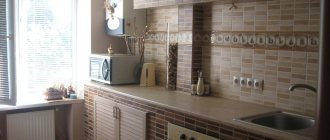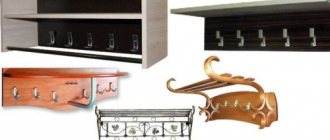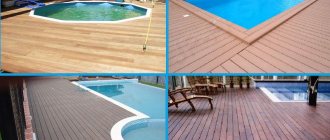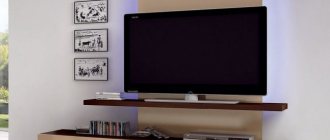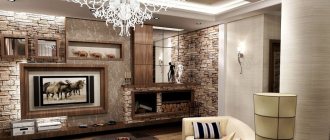Installing a television panel on the wall is one of the most rational solutions that allows you to achieve maximum freedom of space. At the same time, the question arises - how to hide wires that significantly spoil the external aesthetics of the interior? To help you in this matter, we have collected 12 great ideas, among which you will definitely find what you need!
Hiding wires in the wall
At the renovation stage, you can hide the wires from the TV in the wall. To do this, you need to accurately determine the permanent place of “residence” for the television panel.
Next, starting from the intended location of the wire, make a channel in the wall towards the electrical point and lay the cable. Use special construction staples to securely fix it, and then carefully cover it with plaster. Now you can start finishing work.
This method has one significant drawback - the television panel loses its mobility. If you need to move it to another location or send it in for repairs, removing the wire will be very problematic.
Safety - how to hide wires from a child
Many companies producing household goods produce entire series of protective elements designed to maximally protect the little person from electric shock. These produce convenient clips for wires - they are difficult to chew or break, and two to four cords can easily fit inside.
Special integrated designs that allow you to charge a phone or tablet are built into any furniture surface - they are easy to place out of a child’s reach. The same company produces boxes and handbags-cases with buttons - extension boxes and, in part, electrical wires are hidden in them, which allows you to give a neat appearance to the entire room. For some devices, there are completely wireless designs - to charge a tablet, phone, player, you just need to put the gadget on such a charger.
If it was not possible to purchase protective items for laces and extension cords, all “dangerous” items are hidden in large cardboard, plastic, or wooden boxes, which are placed in places inaccessible to the baby.
Masking with a cable channel
Use a camouflage box. With its help you will hide television wires without disturbing the surface of the wall. This structure is fastened with hidden screws and liquid nails.
Today you can purchase a cable channel model that best suits the style of the room. The simplest type is an ordinary plastic box, which after installation can be covered with the same finishing material as the entire wall.
There are models lined with decorative bricks or in the form of pipes, which are ideal for interiors in loft and hi-tech styles. For classic or eco-trends, you can choose wooden or MDF models.
Tips and ways to hide wires in the workplace
In a home office, to make it look neat, the laces coming from the computer and router also need to be removed. A stationery clip will allow you to “run” the cord, which gets tangled under your feet, under the surface of the table - from its very edge. The clip is easy to fix on a wall or shelf, and several of these parts make a kind of separators for the inputs of different charges. If possible, the wires hanging near the back of the table are simply covered with a textile curtain. Some of them can be configured into a mini-hammock - the “head” of an extension cord can easily fit there, along with chargers that would get in the way on the table.
Some companies produce special wire separators - two or more cords are neatly laid inside a wooden, plastic, rubber or metal structure. A cool store-bought option for holding wires, it looks like two wire electrical towers. Pockets made from plastic bottles and clothing pockets look funny - the product is hung on an outlet in the wall, the charger is turned on, and the phone itself and its cord lie quietly in the pocket.
By simply upgrading a desk that has spacious drawers, all the electrical equipment will be neatly hidden there.
Hiding behind drywall
Drywall is widely used in the design of modern interiors, as it allows you to mask surface imperfections and create original decorative designs. Why not take advantage of this?
Come up with a wall structure, for example, in the form of a plasterboard box with niches, shelves and, of course, space for a television panel. After installation, all wires will be securely hidden, and the interior of the room will become more stylish and functional.
You can build a false fireplace from drywall and install a TV above it. This way you will get a great seating area, and the wires will be securely hidden.
How to hide wires in furniture
The TV can be installed in a wall set, which will hide all communications in its depths. But if you don’t like bulky structures, use modular elements, such as a wall cabinet.
Many modern models of such furniture already have special holes in their design into which wires are laid.
Wire panel
If you are a creative person, come up with some kind of wall drawing, the contours of which you will draw with wire. You can find quite a lot of such ideas on the Internet!
Draw a sketch on the wall with a pencil and start laying. Don’t forget that the pattern or geometric figure should fit harmoniously into the interior.
An important point is the method of fixation. Nails are not suitable for this work - they can damage the cable and spoil the design with their unaesthetic appearance. Therefore, use double-sided tape or glue.
Rules for connecting a TV
Wall-mounted TV is an ideal solution for the interior, if only the TV were also wireless. Let's think about how to cover the wires on the wall leading to the TV, since the appearance of hanging cables does not add aesthetics to the design of the room.
Hidden wiring does not interfere with the attractive appearance of the repair; it looks aesthetically pleasing and complete.
The implementation of this task must be carried out taking into account certain wiring and connection rules:
- Slowly think about and plan the location of the TV or TVs so that you can calculate the amount of cable to connect.
- In accordance with the location of the TV, plan the location of sockets and cable outlets;
- purchase only high-quality cable products to avoid their rapid replacement;
- Cables and wires connecting to the TV should not be stretched to allow free connection to the connectors.
Masking with vinyl stickers
Interior vinyl stickers are an excellent decorative material. Its main advantage is that it allows you to quickly transform the interior and emphasize style. At the same time, such decor can be removed or replaced with a new one at any time without any problems.
Use vinyl stickers to create decorations where the TV cable is located. It could be a branchy tree, with the crown of which the cable will blend into the color palette.
Wires behind a wooden panel
Installing a wooden panel with a TV will not only adequately highlight the design of the room, but will also become an excellent camouflage element that will allow you to hide the wires.
Wooden panels can have a different color palette and shape, adding sophistication and presentability to the interior. In addition, the material will serve as a good sound insulator, so you won’t have to worry about the indignation of picky neighbors who are dissatisfied with the increased volume.
Branches of dry and artificial plants
Wires from the TV can also be hidden using branches of artificial plants. Place a vase with dry twigs near or under the TV panel and all attention will shift to an attractive-looking composition.
You can use special wire covers in the form of branches, which are quite similar in design to cable channels, but at an aesthetic level they are much superior. Such functional decor will look great in a children's room.
Internal placement
When a major renovation begins in an apartment or house, the wiring is most often recessed into the walls. First, using a wall chaser, drill, or hammer drill, grooves are made in the wall, into which the cables are then hidden. Wiring in a wooden house must be placed in a protective corrugation - a shell that will protect them from adverse effects and prevent damage.
Communications remain open during cosmetic renovations of the home or when installing new sockets and switches. If you wish, you can always correct the situation without extra costs. There are several methods to hide wires with your own hands.
On the walls
It happens that the wallpaper is already pasted, and you don’t want to violate its integrity. There is an option to eliminate protruding cables without causing serious damage:
- carefully cut the wallpaper or bend it away from the wall close to the floor;
- take a convenient construction tool and make a neat shallow channel in the wall;
- lay the wires in the resulting hole;
- close the channel with a thin layer of plaster or putty;
- let the solution dry;
- glue the wallpaper in its place.
If this method is not suitable, you can proceed without gating - use a decorative box for wires. It is especially common to cover power wires with boxes: they have a large diameter, so they cannot be recessed into the wall without repeated repairs. It is necessary to buy a cable channel that is suitable in color, width, and length, which will serve as an additional decorative element and reliably protect the wiring.
In a wooden house, the box will enhance fire safety measures. This option is also ideal for the bathroom, because it is very difficult to lay wires under the tiles. It is only important to remember that all lighting elements, electrical wiring, and cable ducts must be waterproof.
How else to beautifully hide wiring on the walls? If desired, it can be covered with the following finishing elements:
- door frames;
- various moldings, baguettes;
- window slopes.
It should be noted that only low-current wires (for example, for the Internet, telephone) can be covered with such materials, and high-voltage cables can only be hidden in accordance with fire safety standards.
On the floor
Wiring is often routed along the floor, and here it is even easier to hide it than on the wall. During repairs when laying the screed, you can stretch the cables in corrugation and fill them with cement on top - the communications will be reliable and durable. If there is already a floor covering, it is easy to carefully remove it, punch out recesses with a hammer drill, then push the wires into them and cement them. Under wooden floors, you will have to lay the cables in a metal pipe, after removing the boards.
The stores offer a wide range of floor skirting boards with a hole for wires (with a cable channel). The central part of such a plinth is removed, the cables are laid in the niche, and then the removable element is returned to its place. Working with such skirting boards is convenient, quick, there is no dust, dirt, and the floor material does not deteriorate.
The procedure for laying wires under the most popular coating - laminate - is as follows:
- remove part of the lamellas under which the cable will pass, right down to the construction logs (bars);
- place the cables in the corrugated pipe along or across the joists, if necessary, cutting out space in the wood for the crossing of the wires;
- return the soundproofing pads and lamellas to their original place.
On the ceiling
It is also possible to hide wiring on the ceiling, but the method will depend on the type of coating. In homes and offices, suspended ceilings are often used, which take up excess space, but give the opportunity to route wires as needed by users. There are practically no obstacles for the cables, so it is possible to route them along the shortest path. This has a number of advantages:
- cost reduction;
- reduction of work time;
- reducing the overall circuit resistance;
- strengthening fire safety;
- possibility of easy wiring replacement.
According to fire safety rules, wires and their bundles must be covered with corrugated pipes. The same applies to wiring under suspended ceilings, niches or complex plasterboard structures. It is best to connect communications into a single highway, which will facilitate repairs in the future. If the ceiling is concrete, you will have to drill grooves in it and lay wires in the same way as is done on the walls. This method is very labor-intensive and is rarely practiced.
Wires in “ethnic” style
If the interior of your TV room is decorated in an ethical style or you simply like to surprise with the “quirks” of the interior, take note of the option of masking wires with beads. Of course, you will need fairly large parts that will fit freely on the cable.
Pay attention to the selection of colors - you can choose plain details to match the color of the wall or contrasting ones that attract attention. White and red beads are suitable for wallpaper in warm colors, and blue, green and black - in cold colors.
Hide the extension cord with chargers in a box
The extension cord with chargers constantly gets in the way on the table or under your feet, collects a lot of dust, and also looks unaesthetic. Dealing with this problem is very simple: take a nice box, make a few holes in it and hide all the wires and cables there.
There are also ready-made solutions, for example Plug Hub from Quirky. This is a box made of hard plastic with a rubberized bottom. There are three holes on top for cables, and inside there are three fasteners that can be used to wrap cords that are too long. The Plug Hub can be placed on the floor or mounted on the wall.
amazon.com
Hiding wires with threads and ropes
Another simple way to hide TV wires is to wrap them with colored threads, ribbons or jute rope.
You can choose one of several design methods. For example, simply twist the wire or braid it with a pigtail. The color of the material should be in harmony with the surrounding environment.
How to hide wires on the floor or ceiling: basic recommendations
The cable can be hidden above the floor. For this purpose, special skirting boards with a masking niche for the cable are purchased. Before hiding the wires in the baseboard, its outer panel is removed, and the cable products are removed into the created space. Then the panel is installed back. The advantage of this method is simple, quick and clean installation.
How to hide wires under the baseboard in the floor? To do this, a groove is made in the surface using a puncher. The cable should be laid corrugated. The canal is closed using cement-sand mortar. If the floor is made of wood, the necessary boards are removed. Wires in a metal case are placed into the resulting channel. Another way is to create a new screed on the floor, under which cable products are laid.
Important! If the cable is hidden in the floor, it must be laid in a special corrugation.
When using suspended or suspended ceilings, hiding the cable is much easier than in the case of a concrete floor
Cable products can run along the ceiling. If it is made of concrete, the holes are made in the same way as for walls. How to hide wires on the ceiling when using suspended or tension structures? This type of cable routing is much easier. A space is created between the floor slab and the created ceiling where wires can be located. This option is usually used to provide electricity to lighting fixtures on the ceiling. However, it can also be used as a communication line.
Use books and magazines
Even books can be good helpers in trying to hide television wires. Try to choose ones that have a neat, aesthetic appearance or with bright covers.
Books and magazines can be stacked on a table or shelf under the TV. Pick up a couple of high-end editions that will reach all the way to the television panel. Don't overdo it with the quantity - keep it small so as not to create a mess.
Phytostena
Installing a phytowall is a stylish solution for any modern interior. It is a large panel with “pockets” in which plants are placed. Installing a TV in such a frame has many advantages, one of which is the ability to hide the wires.
In addition to the fact that the design of the room will not be disturbed by the carelessness of a hanging cable, you will be able to enjoy watching your favorite TV shows surrounded by clean, humidified air, which is important for a city dweller!

